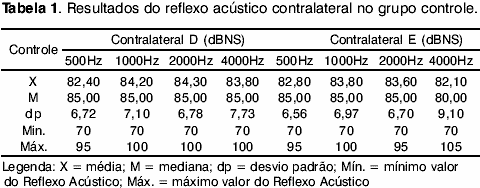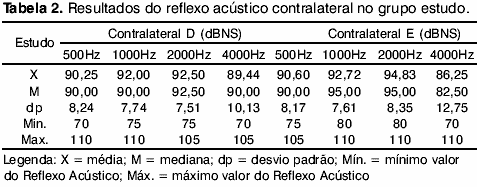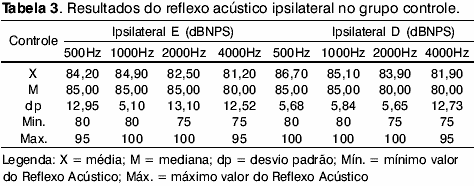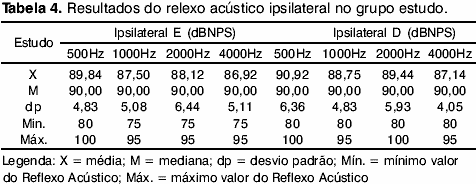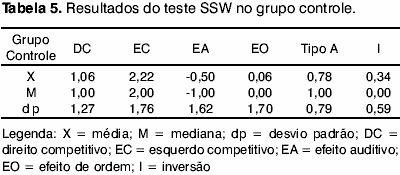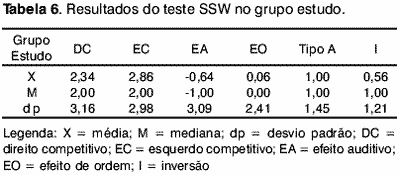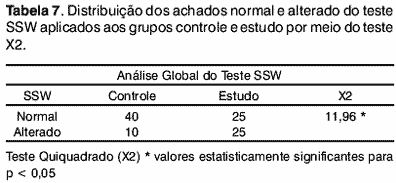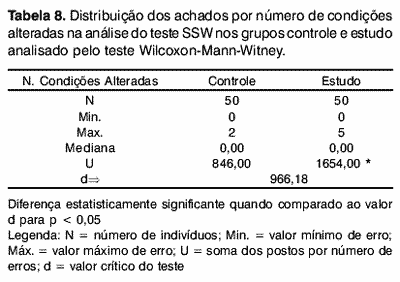

Year: 2002 Vol. 68 Ed. 2 - (16º)
Artigo Original
Pages: 254 to 261
Assessment of auditory processing by ssw test applied to individuals with normal hearing and absence of contralateral acoustic reflex
Author(s):
Rosely Munhoz Bonilha Marotta 1,
Sandra Murad Quintero 1,
Silvio Antonio Monteiro Marone 2
Keywords: acoustic reflex, auditory processing, normal hearing
Abstract:
Introduction: The Acoustic Reflex (AR) is considered to be an important tool for diagnosing hearing disorders. Its threshold is normal when situated within the range of 70 to 90 dBNS. For the AR to occur, it is necessary to have the integrity of the peripheral and central auditory system, especially at the Brainstem level. Brainstem structures related with the AR are also responsible for the Auditory Processing (AP) with regard to the important auditory abilities. Aim: In this study, we have tried to verify the performance of individuals with normal peripheral hearing and absence of Contralateral AR in word recognition in dichotic listening by SSW, Portuguese version. Study design: Clinical prospective randomized. Material and Method: The case records consist of 100 individuals of both sexes and age ranging from 19 to 59. They have been equally divided into two groups, half of them forming a Control group and another half the Study group. The people in the Study group have normal peripheral hearing and absence of Contralateral AR in at least one frequency. Results: There is a statistically relevant difference between these groups as regards the absence of Contralateral and Ipsilateral AR in all bilaterally tested frequencies. As to the SSW Test results regarding normality, the difference has been statistically significant in the conditions of Competitive Right and Competitive Left and Auditory Effect, Order Effect and Type A response trend. During the comparison by the number of errors, the statistically relevant difference has been found in the situations of Competitive Right and Competitive Left. Conclusion: The results of this study reinforce the relevancy of the role of structures responsible for AR in AP, and suggest that the patients with normal peripheral hearing and AR alterations should undergo AP assessment.
![]()
INTRODUCTION
The acoustic middle ear reflex, or in other words, the contraction of the middle ear muscles caused by a loud acoustic stimulus, has been considered an important diagnostic tool in the clinical assessment of hearing, providing data concerning the functioning of the middle ear and the auditory pathways of the central nervous system1.
The superior olivary complex located on the brainstem is considered an important nervous station for the stapedial arc reflex2 and it also seems to be involved in the performance of auditory skills3.
Initially, the role of the acoustic reflex is to protect the inner ear structures from damage caused by loud sounds4. It is likely that this protection role does exist, but a more detailed study of the physiology of the middle ear muscle make us wonder what its real role in auditory processing is. Many theoretical and experimental studies assigned the following functions to the stapedial reflex:
· improvement in auditory attention state to continuous sounds, perception of intensity changes above the auditory threshold, differentiation between the auditory signal and the background noise5;
· attenuation of noise produced by mastication activities, head movements, mandible articulation during speech and mastication5, 6;
· reduction of low frequency masking over high frequencies, extending the dynamic range of the hearing system concerning intensity2, 3, 7, 8;
· participation in the act of vocalizing, with no difference between the onset time of activation of the reflex and the increased intensity of voice or onset of vocalization5, 7, 9;
· improvement in discrimination of speech in loud intensities9, 10 and in frequency selectivity9;
· participation in warning reaction11;
· improvement in location or direction to sound by the binaural interaction of the stapedial reflex3, 5, 12.
The threshold of the acoustic reflex, considered the lowest sound intensity that causes the minimum measurable change in middle ear compliance1, is normal between 70 to 90 dBSL 3, 13.
In the clinical practice, we can find subjects that present audiometry with thresholds within normal range, but with absence of contralateral acoustic reflex.
Conversely, some patients present audiometry within normal ranges and report auditory complaints concerning speech intelligibility.
These situations are explained by the fact that auditory processing is not completed in the peripheral portion of the auditory system. It does not suffice to detect the presence of sounds. It is necessary to convey meaning to them.
Auditory processing is the decoding and interpretation of sound patterns, from the external ear to the cortex. In summary, that is how we can listen to sounds14.
There are a number of tests that assess auditory processing in the central nervous system. They aim at assessing the auditory performance of subjects under real life situations, that is, in the presence of competitive and degraded acoustic signals.
Among the various tests to investigate auditory processing, we may highlight the Word Recognition in Dichotic Listening - SSW, created in 1962 by Katz15 and adapted to Portuguese language in 1986 by Borges16.
All roles of acoustic reflex listed by the international literature are important for the performance of auditory processing skills, and since auditory processing disorder (APD) was defined as a functional deficit, it is possible that the alterations of acoustic reflex are concomitant with the alterations of auditory processing.
The studies that relate acoustic reflex and APD analyze two aspects:
· the performance of subjects with normal audiometry and absence of contralateral acoustic reflex in auditory processing tests; all studies detected worse performance when compared to subjects with normal contralateral acoustic reflex9, 10, 17, 18.
· the occurrence of acoustic reflex abnormalities in patients with APD, resulting in significant correlations between findings3, 19.
Some authors have recently suggested the use of the term auditory processing instead of central auditory processing to emphasize the interaction of the peripheral and central disorder20.
Based on these facts, the purpose of the present study was to check the performance of subjects with normal hearing and absence of contralateral acoustic reflex in word recognition in dichotic listening test, the Portuguese version of SSW16.
MATERIAL AND METHOD
The study was conducted at Clínica Otorhinus - Centro de Diagnose em Otorrinolaringologia, São Paulo - in 100 patients aged 19 to 59 years, distributed as follows:
Control Group - consisted of 50 subjects, 39 women and 11 men aged 19 to 59 years, who presented pure tone air and bone audiometry thresholds d" at 25 dBHL, speech discrimination with SRT compatible with the mean of thresholds 500, 1000 and 2000 Hz21 and Percentage Speech Recognition Index (PSRI) e" at 96% in both ears. They presented acoustic immittance with tympanometric curve Type A22 and presence of ipsilateral and contralateral acoustic reflex in frequencies 500, 1000, 2000 and 4000 Hz bilaterally.
Studied Group - consisted of 50 subjects, 36 women and 14 men, aged 19 to 59 years, who presented pure tone air and bone audiometry thresholds d" at 25 dBHL, speech discrimination with SRT compatible with the mean of thresholds 500, 1000 and 2000 Hz21 and Percentage Speech Recognition Index (PSRI) e" at 96% in both ears. They also presented acoustic immittance with tympanic curve Type A27 and absence of contralateral acoustic reflex in one or more tested frequencies (500, 1000, 2000 and 4000 Hz), uni or bilaterally.
We tried to match gender and age factors between the control and studied groups.
All patients were Brazilian, Portuguese speakers and had completed primary school. They were all right-handed.
We excluded from the study patients who had earwax, otological affections and previous or current neurological disorders.
Procedures:
- Meatoscopy to exclude the presence of earwax;
- Anamnesis to collect personal data, auditory complaints and others;
- Pure tone audiometry testing auditory thresholds in frequencies 250, 500, 1000, 2000, 3000, 4000, 6000 and 8000 Hz and speech discrimination, with SRT (Speech Reception Threshold) and Percentage Speech Recognition Index (PSRI) performed in sound-proof booth, using audiometer brand Maico MA41, phones TDH-39 and pad MX41.
- Acoustic immittance measures with tympanometry and contralateral acoustic reflex (dBHL) and ipsilateral acoustic reflex in frequencies 500, 1000, 2000 and 4000 Hz, with the device brand Damplex model ZA-28, probe 226 Hz and phone TDH39. The maximum output was 120 dBHL for Contralateral reflex and 100 dBSPL for Ipsilateral reflex.
- SSW test, adapted to Portuguese15, using the audiometer brand Madsen model Midimate 602, phones TDH-39, pad MX41 and CD player Sony, model D-181, presenting the test by the attached CD, Vol. 2/Track 623.
In the analysis of results, we compared the groups using central tendency measures (mean, median) for the findings of the contralateral and ipsilateral acoustic reflex and SSW results considering quantitative measures, in the conditions Competitive Right (DC) and Competitive Left (EC) and qualitative, in the tendencies of auditory effect responses (EA), order effect (EO), Type A and Inversion (I).
Groups were statistically compared using the Chi-square test (x2) concerning absence and presence of contralateral and ipsilateral acoustic reflex, normal findings and thresholds above the contralateral acoustic reflex limits and normal findings and abnormal results in the analysis of SSW test.
We used the normal range of SSW test proposed by Katz (1996)24.
Groups were also statistically compared using Wilcoxon-Mann-Witney test to analyze number of errors in the analysis of SSW test.
In all tests, we fixed the 5% rejection level for null hypothesis.
The study was approved by the ethics committee on research - CAPPesq, at Hospital das Clínicas, Medical School, University of São Paulo, under the protocol no 365/99 on 26/8/99.
RESULTS
In order to facilitate reading and analysis of data, they were divided as follows:
I. Results of acoustic reflex detection.
Mean, medians, standard deviations, maximum and minimum values of thresholds of contralateral reflexes in the control and studied groups are shown, respectively, in Tables 1 and 2.
The percentages of absence of the contralateral acoustic reflex in the studied group for right afference were 20%, 20%, 28% and 64% and for left afference, 34%, 34%, 42% and 84% respectively, for frequencies 500, 1000, 2000 and 4000 Hz. The percentages of abnormal contralateral acoustic reflex, including absent findings and above the reflex limits, increased considerably for the right afference to 52%, 58%, 64% and 76% and to left afference to 62%, 68%, 76% and 88% respectively, for 500, 1000, 2000 and 4000 Hz.
In the distribution of number of absent/present findings and normal/above threshold of contralateral acoustic reflex, we could observe statistically significant differences between the groups in all tested frequencies, except for 4000Hz in the analysis of normal findings and above the thresholds for bilateral afference, using chi-square test.
Means, medians, standard deviations, maximum and minimum values of thresholds of ipsilateral acoustic reflex for the control and studied groups are respectively shown in Tables 3 and 4.
In the distribution of percentages of absent ipsilateral acoustic reflex in the studied group by frequency, we found the values 44%, 44%, 46% and 58% on the right afference and 36%, 36%, 36% and 48% on the left afference, respectively, for 500, 1000, 2000 and 4000 Hz.
These high occurrences of absent ipsilateral acoustic reflex showed statistically significant differences in the comparison of findings of absence and presence of the studied and control groups in all frequencies tested bilaterally, using the x2 statistical test.
II. Results of the Word Recognition in Dichotic Listening - SSW
Means, medians, standard deviations and number of errors of the SSW test in the quantitative analysis (DC and EC conditions) and qualitative analysis (EA, EO, Type A and I) in the control and studied groups are shown in Tables 5 and 6.
In the DC condition, 7 subjects of the control group (14%) and 18 of the studied group (36%) presented abnormal results. In the EC condition, 4 subjects of the control groups (8%) and 13 of the studied group (26%), presented abnormal results. The differences were statistically significant by means of the x2 test. When the same conditions are compared to numbers of errors, using the Wilcoxon-Mann-Witney test, we found statistically significant differences.
Competitive conditions DC and EC were compared in the control and studied groups to assess the difference in performance of the right and left ears. As to normal and abnormal findings, they did not show statistically significant differences in the subjects of the control and studied groups, which happened only in the comparison by number of errors in the control group, with the worst performance on the left ear.
Upon comparing normal and abnormal findings of the control and studied groups in the response tendencies of qualitative analysis, we found statistically significant differences in EA, EO and type A and no significance for I. As to number of errors, none of them showed statistically significant differences.
The comparison of normal and abnormal findings in the joint analysis of SSW test, using the chi-square test, is described in Table 7. We considered abnormal results for the SSW test when the subjects presented one or more abnormal conditions and normal results when subjects did not present any abnormal conditions.
The comparison of number of abnormal conditions in the joint analysis of SSW test using Wilcoxon-Mann-Witney test, is described in Table 8.
DISCUSSION
The importance of the acoustic reflex in auditory processing is still questioned.
There is a trend towards believing that acoustic reflex has the role of only protecting the inner ear from damage caused by exposure to loud intensity sounds4.
However, the neural complexity involved in the mechanism of stapedial arc reflex makes us believe that it may be the simplest role of the reflex.
Theoretical and experimental studies related the functions of the middle ear muscles to auditory skills such as sound location and frequency selectivity, among others3.
Among the studies that relate auditory processing and acoustic reflex, the study by Carvallo3 is considered a landmark in the Brazilian scientific production.
Taking it for granted that there is a close link between the acoustic reflex and the auditory processing, the present study intended to correlate the most important findings of the SSW test in subjects with normal hearing and absence of contralateral acoustic reflex.
Therefore, we shall discuss the results of our investigation next:
· Findings related to the analysis of the Acoustic Reflex (AR)
The measures of contralateral AR thresholds in subjects of the studied group were higher when compared to the subjects of the control group in all tested frequencies, bilaterally, and they were not within the normal ranges of sensation level intensities in frequencies 500, 1000 and 2000 Hz3,13.
We did not find in our study isolated absence of contralateral AR in frequencies 500Hz, different from the results of other studies1.
The occurrence of AR abnormalities, including the findings of absence of AR and AR above the normal expected thresholds, was greater than 50% for all frequencies tested bilaterally, leading us to the conclusion that the analysis of AR threshold increase in dBSL is important.
Upon comparing contralateral AR findings of absence/presence and normal/greater levels than threshold, there were statistically significant differences between the control and studied groups in all tested frequencies, bilaterally, except for 4000Hz in the comparison of normal findings and above the limit, probably owing to the great number of occurrences of absences of contralateral AR in this frequency.
We considered high the occurrence of isolated absence of contralateral AR in 4000Hz (40%) and questioned the absence of pathological meaning proposed by the literature25.
The mean of thresholds of ipsilateral AR was higher in the studied group than in the control group. We observed a high incidence of absence of ipsilateral AR in all tested frequencies, resulting in statistically significant differences when comparing the findings of absence and presence of reflex in 500, 1000, 2000 and 4000 Hz, bilaterally. The findings are different from those obtained in patients with brainstem affection in which the authors observed absence of contralateral AR, but presence of ipsilateral AR1, 26, 27, 28.
Loudness has the same nervous pathway as the stapedial acoustic reflex3, 29, and the fact made us wonder whether the superior olivary complex performs an incorrect intensity analysis of the stimulus, since it could indicate auditory processing disorder, leading to impairment of important auditory skills.
· SSW-related findings
The mean of number of errors of the Quantitative and Qualitative Analyses of the SSW test proved to be greater in the studied group subjects than in control group ones, under the situations of DC and EC and response tendency of EA, Type A and I and equivalent for EO. These findings revealed worse performance in the SSW for subjects who had absence of AR, agreeing with the other studies that employed AP tests in subjects who had absent AR9, 10, 17, 18.
Upon comparing the normal and abnormal findings of the Quantitative and Qualitative analyses, we found statistically significant differences between the groups under the conditions DC. EC and response tendencies for EA, EO and Type A, and no significance for I.
In the same comparison for number of errors, we found statistically significant differences only for the conditions DC and EC.
The fact that we detected statistically significant differences in the analysis of normal and abnormal findings and no significance in the number of error analysis showed us that the differences between the groups were minor, but sufficiently to separate them into normal and abnormal.
In the interaural comparison of conditions DC and EC of the quantitative analysis of SSW test, we did not find statistically significant differences concerning normal and abnormal findings for subjects of the control and studied groups.
In the same comparison for number of errors, we observed statistically significant differences in subjects of the control group, with worse performance for the EC condition, confirming the advantage of the right ear in situations of dichotic listening30.
In subjects of the studied group, there were no statistically significant differences between the conditions DC and EC considering number of errors, probably due to the large number of errors also in the DC condition, indicating absence of advantage of the right ear.
We could suppose that the absence of right ear advantage in subjects of the studied group who presented AR abnormality could explain the worse performance of the subjects in the SSW test comparing to the subjects of the control group.
In the joint quantitative and qualitative analyses of SSW test, we observed statistically significant differences both for the global analysis of the test and the comparison by number of abnormal conditions, pointing to worse performance for the studied group.
AR, as reported in the literature, participates actively in a number of significant auditory skills for AP, explaining the difference in the performance of the groups and agreeing with the findings of innumerous studies with AP tests in subjects with AR abnormalities9, 10, 17, 18.
We hypothesized that AR abnormalities result in worse damage to AP, since the mechanism of the stapedial muscle seems to be directly correlated with the easiness in recording speech sounds, which could create conditions for better decoding of information and, thus, of speech intelligibility.
The results of worst performance in SSW test of subjects with abnormal AR that can not be justified based on audiometric abnormalities suggest that subjects with acoustic reflex abnormalities be submitted to auditory processing tests, since the symptoms may be manifestations of a central auditory nervous system pathology.
CONCLUSION
After the analysis of the results, we concluded that:
- there was higher occurrence of abnormalities in two-syllable word recognition in dichotic listening in the group of subjects with acoustic reflex abnormalities;
- the findings of abnormal acoustic reflex, including absent reflex and thresholds over the maximum normal range, may also indicate the presence of alterations of auditory skills related to auditory processing;
- the findings of the worst performance in SSW test for the group of subjects with abnormal reflex reinforced the correlation between auditory processing and acoustic reflex.
REFERENCES
1. Northern JL, Gabbard SA, Kinderdl. O Reflexo Acústico. In: Katz J. Tratado de audiologia clínica. 3ª ed. Local Manole; 1989. Cap. 24 p.483-503.
2. Borg E. On the neuronal organization of the acoustic middle ear reflex. A physiological and anatomical study. Brain Research 1973; 49:101-23.
3. Carvallo RMM. O efeito do reflexo estapediano no controle da passagem da informação sonora. In: Schochat E. Processamento Auditivo - Série Atualidades em Fonoaudiologia. Lovise Ed.; 1996. p.57-73.
4. Wever EG, Lawrence M. Psychological Acoustics. Princeton University Press; 1954.
5. Simmons FB. Perceptual theories of middle ear muscle function. J Acoust Soc 1962;34 :1524-34.
6. Carmel P, Starr A. Acoustic and nonacoustic factors modifying middle ear muscle activity in waking cats. J Neurophysiol 1963; 26:598-616.
7. Borg E, Zakrisson JE. Stapedius reflex and monoaural masking. Acta Otolaryngol 1974;78:155-61.
8. Liberman MC, Guinan Jr. Feedback control of the auditory periphery: anti-masking effects of middle ear muscles vs. olivocochlear efferents. J Commu Disord 1998;31:471-81.
9. Colletti V, Fiorino F, Verlatog, Carner M. Acoustic reflex selectivity: brain stem auditory evoked response and speech discrimination. In: Katz J. Auditory processing: a transdisciplinary view 1992;39-46.
10. Wodmald PJ, Rogers C, Gatehouse S. Speech discrimination in patients with Bell's palsy and a paralysed stapedius muscle. Clin Otolaryngol 1995;20:59-62.
11. Greisen O, Neergaard EB. Middle ear reflex activity in the startle reaction. Arch Otolaryngol 1975;101:348-53.
12. Iguchi Y, Ogawa Y, Tada Y, Kodoma N. Binaural interaction of stapedius reflex. Acta Otolaryngol (Stockh) 1996; [Suppl]524:335.
13. Metz O. Threshold of reflex contraction of muscles of middle ear and recruitment of loudness. Arch Otolaryng (Chic.) 1952;55:536-43.
14. Katz J, Stecker NA, Henderson D. Central Auditory Processing: a transdisciplinary view. Saint Louis Mosby Year Book, 1992. Cap.1, p.38.
15. Katz J. The use of staggered spondaic words for assessing the integrity of central auditory nervous system. J Aud Res 1962;2:327-37.
16. Borges ACC. Adaptação do teste SSW para a língua portuguesa: nota preliminar. Acta Awho 1986; 5 Suppl 1: 38-40.
17. Anastasio ART. SSI- um estudo comparativo em adultos jovens com e sem alteração do reflexo acústico contralateral. [Dissertação Mestrado] Pontifícia Universidade Católica de São Paulo, São Paulo; 2000.
18. Dorman M, Cedar I, Leek M, Lindhoml JM. Influence of the acoustic reflex on vowel recognition. J Speech Hear Res 1986;29:420-4.
19. Meneghello J, Domenico MLD, Costa MCM, Leonhardt FD, Barbosa LHF, Pereira LD. Ocorrência de reflexo acústico alterado em desordens do processamento auditivo central. ANAIS: 35. Congresso Brasileiro de Otorrinolaringologia. Natal. RN. Temas livres 2000.
20. Jerger J, Musiek F. Conference of A.A.A. University of Texas-Dallas. April 2000. Collected on 18-01-2001. Site: http://www.audiology.org/professional/jaaa/11-9a.php.
21. Santos TAM, Russo ICP. A Prática da audiologia clínica. 4ª ed. São Paulo: Cortez; 1994. cap.IV p.81-95.
22. Jerger J. Clinical experience with impedance audiometry. In: Arch Otolaryngol 1970;92:311-24.
23. Pereira LD, Schochat E. Processamento auditivo central: manual de avaliação. São Paulo: Lovise; 1997.
24. Katz J. 1996 Apud Borges ACLC. Análises de número de erros. In: Pereira LD, Schochat E. Processamento auditivo central: manual de avaliação. São Paulo: Lovise; 1997. Cap. 9 p.178.
25. Jerger J, Jerger S, Mauldin BS. Studies in impedance audiometry: normal and sensorineural ears. Arch Otoralyngol 1972;96:51323.
26. Greisen O, Rasmussen PE. Stapedius muscle reflexes and oto-neurological examinations in brain-stem tumors. Acta Otolaryngol 1970; 70:366-70.
27. Musiek FE, Baran JA. Assessment of the human central auditory nervous system In: Altschuler RA. Neurobiology of hearing: the central auditory system. New York: Raven Press Ed.; 1991. p. 411-37.
28. Musiek FE, Bornstein SP. Contemporary aspects of diagnostic audiology. Am J Otolaryngol 1992;13:23-33.
29. Djupesland G, Sundby A, Flottorp G. Temporal summation in the acoustic stapedius reflex mechanism. Acta otolaryng 1973;76:30512.
30. Kimura D. Some effects of temporal-lobe damage on auditory perception. Canadian J of Psychol 1961;15:156-65.
1 Audiologist, Master in Sciences, Department of Experimental Pathophysiology, Medical School, University of São Paulo/USP, works at Sector of Audiology, Clínica Otorhinus - Centro de Diagnose em Otorrinolaringologia, São Paulo.
2 Ph.D., Professor, Department of Otorhinolaryngology, Medical School, University of São Paulo/USP, director of Clínica Otorhinus - Centro de Diagnose em Otorrinolaringologia, São Paulo.
Study conducted at Clínica Otorhinus - Centro de Diagnose em Otorrinolaringologia - SP - Rua Cubatão, 1140 -Vila Mariana São Paulo - SP Tel: (55 11) 5572.0025.
Address correspondence to: Rosely Munhoz Bonilha Marotta - Rua Padre João Manuel, 461 apto. 71 - Cerqueira César - São Paulo - CEP 01411-001 SP
Article submitted on July 27, 2001. Article accepted on December 01, 2001.
